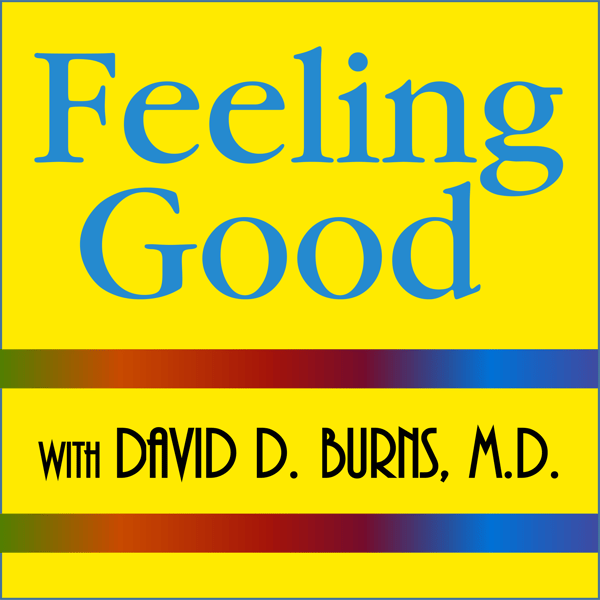023: Scared Stiff — What Causes Anxiety? What’s the Cure? (Part 2)
Feeling Good Podcast | TEAM-CBT - The New Mood Therapy
David Burns, MD
4.4 • 856 Ratings
🗓️ 13 February 2017
⏱️ 23 minutes
🧾️ Download transcript
Summary
There are 4 powerful treatment models for anxiety, including
- The Cognitive Model
- The Exposure Model
- The Motivational Model
- The Hidden Emotion Model
Each approach has a completely different theory about the causes of anxiety and utilizes completely different treatment techniques. For example, cognitive therapists believe that distorted thoughts trigger all anxiety, and that the most effective treatment involves challenging these distortions. In contrast, exposure therapists argue that avoidance is the cause of all anxiety, and that exposure is the only effective treatment. Those who adhere to the Motivational Model emphasize the role of resistance. In other words, anxious individuals are reluctant to let go of the anxiety because they secretly believe that the anxiety will protect them from danger. And those who adhere to the Hidden Emotion Model claim that “niceness” is the true cause of all anxiety in the United States at this time, and that hidden problems and feelings may need to be brought to conscious awareness before the patient can recover.
Dr. Burns argues that, in fact, all four theories are correct, and that if you skillfully integrate all four approaches, you will often see a rapid and total elimination of anxiety in the great majority of your patients.
Dr. Burns describes how he created the Hidden Emotion Model when he was treating a woman with mysterious and intractable case of Panic Disorder. Every time her boss walked past her desk, she became nauseous and panicky, and had the overwhelming urge to vomit on him. Then she would have to rush to the ladies’ room to rest until the nausea and panic diminished, and she sometimes had to go home because the symptoms were so severe. This was all the more puzzling because she insisted she had the best boss in the world and that there were no problems at work. She explained that her boss constantly praised her and gave her promotions and generous raises, and that she had no complaints whatsoever.
Cognitive and exposure techniques were only partially effective, until an unexpected discovery suddenly emerged during a therapy session that led to a surprising outcome. What do you think the hidden emotion was? Tune in and you’ll find out!
In the next several podcasts, Drs. Burns and Nye will bring these four models to life, using real life examples, including some of Drs. Burns’ personal struggles with anxiety early in his career.
Transcript
Click on a timestamp to play from that location
| 0:00.0 | Hello and welcome to the Feeling Good podcast. |
| 0:12.4 | I am your host, Fabrice Knight. |
| 0:14.7 | And joining me here in the Murrieta Studios is Dr. David Burns. |
| 0:19.0 | Hi, David. |
| 0:20.0 | Hi, Fabrice. |
| 0:23.8 | Dr. David Burns has been a pioneer in the development of cognitive therapy, and he is the creator of the new team therapy. He is the author of |
| 0:30.2 | Feeling Good, which has sold over 5 million copies in the United States, and has been translated into |
| 0:35.5 | over 20 languages. He is an emeritus adjunct clinical professor |
| 0:40.0 | of psychiatry at the Stanford University School of Medicine. Now, David, we've kind of given |
| 0:47.0 | an overview in the last podcast about anxiety, what causes it. So today we're going to talk about |
| 0:53.9 | the different treatment models. Yeah, how to treat it. Yeah today we're going to talk about the different treatment models. |
| 0:56.7 | Yeah, how to treat it. |
| 0:57.7 | Yeah, how to treat it. |
| 0:58.9 | But we're going to start with the models because I know you have different ways to look at |
| 1:03.3 | treatment for anxiety. |
| 1:05.3 | Yeah. |
| 1:05.9 | And so let's see what those different models are. |
| 1:09.1 | Yeah. |
| 1:09.3 | You know, I guess we could say there's five models, actually. |
| 1:14.5 | If we include the biological model of anxiety, |
| 1:17.5 | that's where you're treating it with medications and pills. |
| 1:20.9 | And we'll certainly have a podcast addressing that issue. |
... |
Please login to see the full transcript.
Disclaimer: The podcast and artwork embedded on this page are from David Burns, MD, and are the property of its owner and not affiliated with or endorsed by Tapesearch.
Generated transcripts are the property of David Burns, MD and are distributed freely under the Fair Use doctrine. Transcripts generated by Tapesearch are not guaranteed to be accurate.
Copyright © Tapesearch 2025.

